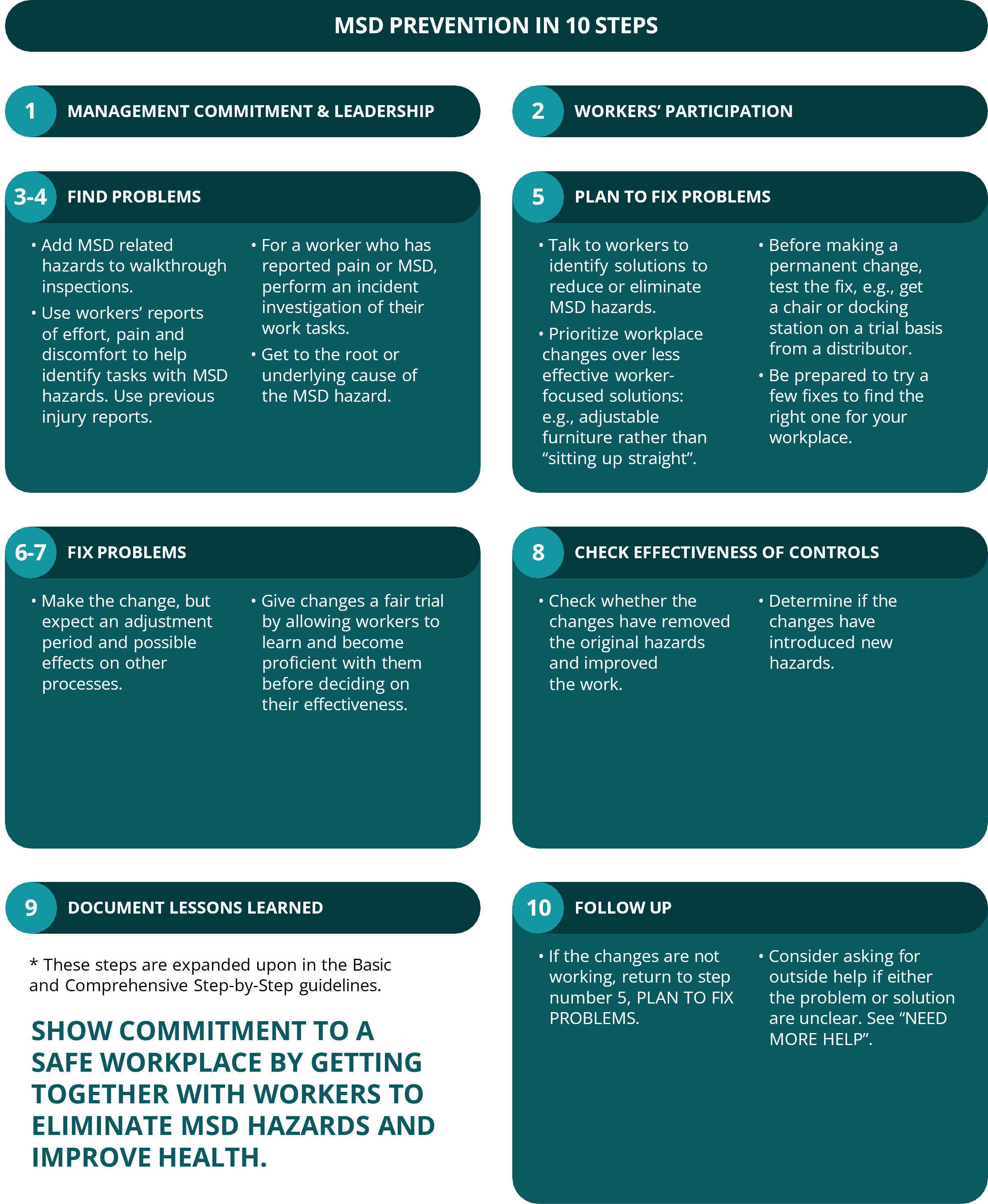Quick Start Office Folder
Office work shouldn’t hurt
Back pain, sore necks and other Musculoskeletal Disorders (MSD) are a major cause of workers’ disability and costs to workers, business and
society. Eliminating and reducing MSD hazards at the office is one part of creating a safe workplace. Small changes at work can make a big difference in preventing the development of MSD.
Most people use computers in their work and at home. They use desktop computers, laptops, touch pads, tablets and cell phones.
They work with them in offices, but also in warehouses, restaurants, automobiles, construction sites and at home. For simplicity, we will call all of these situations “Office Work”. The goal of “Office Ergonomics” is to improve health and effectiveness during office work.
This Guide contains workplace fixes to help keep backs, shoulders, necks, wrists and eyes happy & healthy during office work. It was written mainly for small businesses. Its goal is to provide basic information and encourage firms to get started on preventing MSD at work. It is a part of a larger resource: The MSD Prevention Guideline for Ontario (www.msdprevention.com). For non-office work, see the companion resource, Quick Start Guide: General.
JOHN’S SORE NECK WAS GETTING WORSE...
After talking with his boss who had reviewed the Quick Start Guide: Office, John realized that he was leaning forward in his chair in order to see better and his head was tilted backwards in a “pigeon neck” posture. The Quick Start Guide helped them both understand the underlying problems: the computer screen was positioned too far away when it should have been at arm’s length from John's eyes. The screen also wasn't at eye height, which allows for a downward gaze and therefore a reduction in fatigue and discomfort in both the neck and eyes.
To make matters worse, when John’s boss asked about the last time he had had his prescription updated, John realized that his bifocals were an old prescription. After readjusting the computer screen distance and height and getting an updated prescription suitable for computer work, John’s neck felt better.
Note: Employers have a legal responsibility to provide a safe workplace under the Ontario Occupational Health and Safety Act. This includes improving the workplace and putting in place measures to protect workers from all hazards, including those related to musculoskeletal disorders.
Making a Start
Starting is the most important part of reducing back pain, sore necks, tired eyes and other Musculoskeletal Disorders (MSD). A workplace free of MSD hazards protects workers from injuries, lets injured workers return to their jobs more easily and allows people with varying abilities to continue working: male or female; old or young; tall or short. For workers who have had an injury or illness – including MSD – a health care professional could use the materials in this guide as a starting point and adapt the recommendations appropriately.
This Quick Start Guide: Office and the companion Quick Start Guide: General will give businesses a good start.
Actions
- Jump straight in. Start using these posters in your workplace inspections and safety talks and then make changes to remove or reduce any hazards found.
- Follow the 10 steps on the facing page for a more systematic approach.
Some of the ideas presented in the mini-posters may seem simple, but you can substantially reduce MSD hazards by applying these ideas throughout your office (and home).
Set Up a Standard Office Workstation
There is no single “correct” working position that fits everybody’s work tasks and body and allows comfort for extended periods of time.
- Workers should receive training from their employer on how to adjust their office equipment.
- Workers should get their eyesight checked and corrected if necessary. If vision is not corrected for
screen-based tasks, the following steps may not be effective in preventing fatigue and discomfort. - A chair with adjustability is an important component of an office setup. It lets workers fit their workstation to their body and work: Feet on floor (or foot support), sit back on the seat, no pressure behind the knees, backrest with slight lean backwards, support for the low back (lumbar) area.
- Modify or adjust the furniture to place the keyboard at about elbow level with the mouse close to the side of the keyboard. The goal is to have the forearms approximately horizontal, with the wrists straight and not bent back.
- Modify or adjust the furniture or equipment to position the top of the screen at or below eye level and about an arm’s length away.
- Set the lighting, computer and display settings to give sharp, good-sized text, good contrast and no glare.
- All the parts of the workstation have to work together: After adjusting the individual parts of workstation, fine-tune the setup so the workstation fits your body and tasks.
These steps are a good start but for comfortable and effective office work with computers, workers should also be able to:
- Look away from the screen often and perform non-screen based tasks to help reduce discomfort in the eyes and body, e.g., walk to the printer. These introduce breaks and pauses into work. Stretching can help too.
- Change your activity or posture when you feel they need to, but remember, fatigue creeps up slowly on you, so Move early—before you feel fatigue—and move often.

These steps are expanded upon in the basic and comprehensive guidelines.
